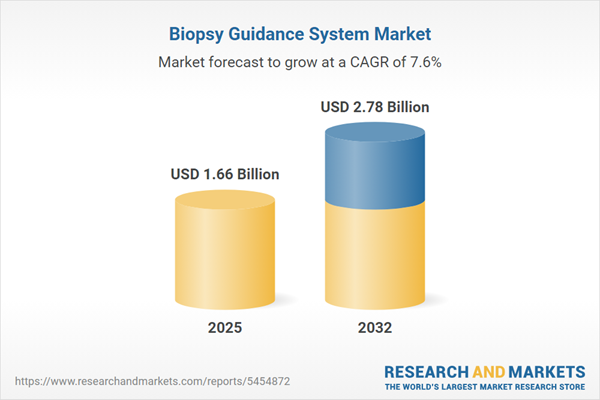Speak directly to the analyst to clarify any post sales queries you may have.
The Biopsy Guidance System Market is evolving rapidly, driven by the demand for minimally invasive diagnostics and growing integration of advanced imaging and automation within clinical practice. Senior leaders face critical decisions about technology adoption, supply chain resilience, and operational optimization as the sector adapts to complex regulatory, economic, and technological shifts.
Market Snapshot: Biopsy Guidance System Market Growth and Trends
In 2024, the Biopsy Guidance System Market was valued at USD 1.54 billion and is projected to reach USD 1.66 billion by 2025. With an expected CAGR of 7.61%, the market is forecasted to achieve USD 2.78 billion by 2032. This substantial growth is fueled by technological innovation, expansion of minimally invasive procedures, and shifts in healthcare delivery worldwide.
Scope & Segmentation
This report covers diverse aspects of the biopsy guidance ecosystem, ensuring insights into every critical segment and stakeholder:
- Imaging Technology: Computed Tomography, Magnetic Resonance Imaging, Stereotactic platforms, X Ray, 2D Ultrasound, 3D Ultrasound, Doppler Ultrasound
- Application: Breast, Kidney, Liver, Lung, Prostate, Thyroid
- End User: Ambulatory Surgical Centers, Diagnostic Imaging Centers, Hospitals, Private Hospitals, Public Hospitals, Outpatient Clinics
- Biopsy Type: Core Needle Biopsy (Spring Loaded, Vacuum Assisted), Fine Needle Aspiration
- Guidance System: Manual, Robotic Assisted
- Regional Coverage: Americas (including North America, United States, Canada, Mexico, Latin America—Brazil, Argentina, Chile, Colombia, Peru), Europe (United Kingdom, Germany, France, Russia, Italy, Spain, Netherlands, Sweden, Poland, Switzerland), Middle East (UAE, Saudi Arabia, Qatar, Turkey, Israel), Africa (South Africa, Nigeria, Egypt, Kenya), Asia-Pacific (China, India, Japan, Australia, South Korea, Indonesia, Thailand, Malaysia, Singapore, Taiwan)
- Key Companies Analyzed: GE HealthCare Technologies Inc., Siemens Healthineers AG, Koninklijke Philips N.V., Hologic, Inc., Canon Medical Systems Corporation, Medtronic plc, FUJIFILM Holdings Corporation, Hitachi, Ltd., Samsung Medison Co., Ltd., Esaote S.p.A.
Key Takeaways
- Hybrid imaging solutions and advanced workflow integration underpin a shift toward greater precision, supporting real-time adaptation during complex diagnostic interventions.
- Artificial intelligence and robotic-assisted platforms deliver enhanced targeting accuracy, lower repeat procedure rates, and contribute to operational cost efficiency.
- Varying clinical requirements by organ type and care setting mean adaptable guidance system platforms are favored for broad market penetration.
- Regional differences in reimbursement, procurement cycles, and technology infrastructure shape adoption curves and vendor strategies globally.
- Strategic alliances—particularly in imaging, software, and materials—drive the delivery of modular, scalable solutions tailored to individual end-user needs.
- Ongoing investments in training and data-driven performance analytics ensure clinical competencies and system uptime align with procedural throughput goals.
Tariff Impact
Escalating United States tariff measures on imported components have prompted manufacturers to reconfigure global supply chains. Adjustments include expanding production in tariff-exempt locations, enhancing supply contract durations, and investing in alternative materials to safeguard pricing stability and supply continuity. These adaptations support market resilience but may introduce longer procurement and inventory lead times for healthcare providers.
Methodology & Data Sources
This report leverages structured interviews with clinicians, engineers, and procurement experts, complemented by a thorough review of academic literature, regulatory filings, and industry data. Advisory panel workshops validated core assumptions and harmonized input across multiple regions for robust, actionable output.
Why This Report Matters
- Supports strategic planning for technology investments, supplier relationships, and clinical deployment pathways.
- Enables benchmarking against leading vendors, competitor partnerships, and platform capabilities for informed capital allocation.
- Delivers a holistic view of market dynamics, regulatory trends, and potential risks across geographies and clinical settings.
Conclusion
The biopsy guidance system market is at a pivotal juncture, with significant innovation and operational adaptation underway. Organizations equipped with robust insights into evolving technologies, regional trends, and collaborative strategies will be well positioned to lead in minimally invasive diagnostics.
Additional Product Information:
- Purchase of this report includes 1 year online access with quarterly updates.
- This report can be updated on request. Please contact our Customer Experience team using the Ask a Question widget on our website.
Table of Contents
3. Executive Summary
4. Market Overview
7. Cumulative Impact of Artificial Intelligence 2025
Companies Mentioned
The companies profiled in this Biopsy Guidance System market report include:- GE HealthCare Technologies Inc.
- Siemens Healthineers AG
- Koninklijke Philips N.V.
- Hologic, Inc.
- Canon Medical Systems Corporation
- Medtronic plc
- FUJIFILM Holdings Corporation
- Hitachi, Ltd.
- Samsung Medison Co., Ltd.
- Esaote S.p.A.
Table Information
| Report Attribute | Details |
|---|---|
| No. of Pages | 189 |
| Published | October 2025 |
| Forecast Period | 2025 - 2032 |
| Estimated Market Value ( USD | $ 1.66 Billion |
| Forecasted Market Value ( USD | $ 2.78 Billion |
| Compound Annual Growth Rate | 7.6% |
| Regions Covered | Global |
| No. of Companies Mentioned | 11 |









